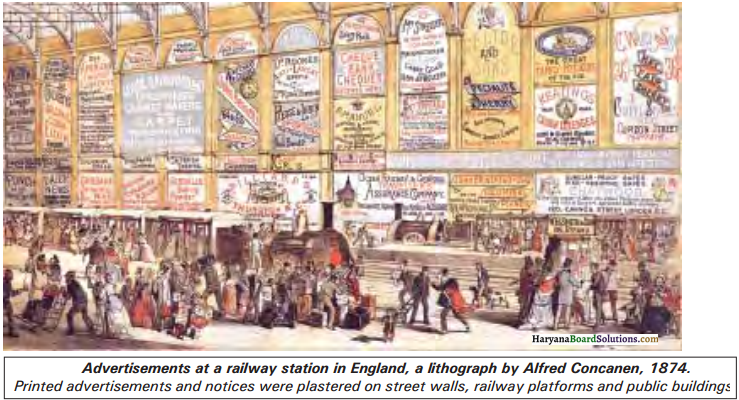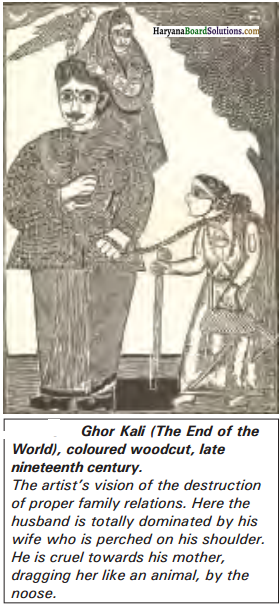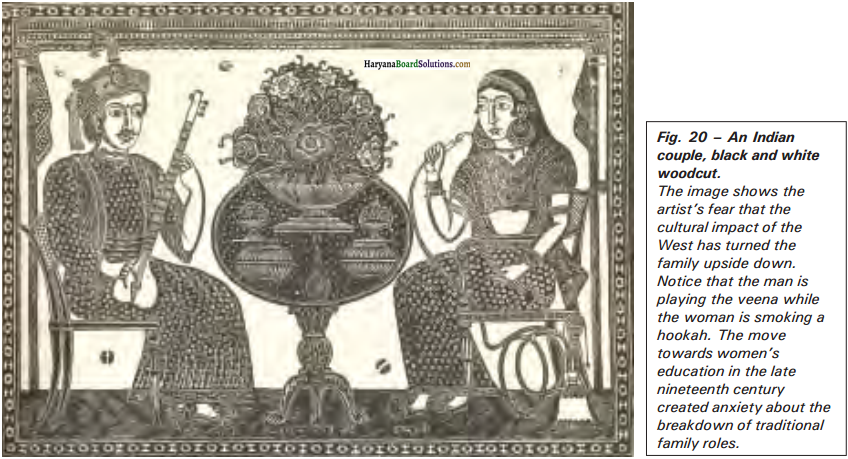Haryana State Board HBSE 10th Class Social Science Solutions History Chapter 5 Print Culture and the Modern World Textbook Exercise Questions and Answers.
Haryana Board 10th Class Social Science Solutions History Chapter 5 Print Culture and the Modern World
HBSE 10th Class History Print Culture and the Modern World Intext Questions and Answers
Activity (Page No. 108)
Print Culture And The Modern World Class 10 Important Questions And Answers HBSE
Question 1.
Imagine that you are Marco Polo. Write a letter from China to describe the world of print which you have seen there.
Answer:
As Marco Polo, I shall write the following letter about the print technology, which I have seen in China.
Books in China are printed by rubbing paper against the inked surface of wood blocks. As, both sides of the thin and porous sheet cannot be printed, the traditional Chinese ‘accordion book’ is folded and stitched at the side. Superbly skilled craftsmen can duplicate it with remarkable accuracy, with the beauty of calligraphy.
Activity (Page No. 111)
Class 10th History Chapter 5 Question Answer HBSE Question 1.
You are book-seller advertising the availability of new cheap printed books. Design a poster for your shop window.
Answer:
Design a poster with the help of your teacher.
Activity (Page No. 116)
Print Culture And The Modern World Question Answers HBSE 10th Class Question 1.
Imagine that you are a cartoonist in France before the revolution. Design a cartoon as it would have appeared in a pamphlet.
Answer:
Design a cartoon with the help of your teacher.
![]()
Activity (Page No. 118)
HBSE New History Book 10th Class Question 1.
Look at text book What impact do such advertisements have on the public mind? Do you think everyone reacts to printed material in the same way?

Answer:
- Such advertisements influence people’s minds immensely. They divert their thoughts and provoke them to buy the advertised products.
- No, everyone does not react to printed material in the same way.
Activity (Page No. 126)
Question 1.
Look at textbook carefully.
(i) What comment are the artists making on the social changes taking place in society?
(ii) What changes in society were taking place to provoke this reaction?
(iii) Do you agree with the artist’s view?
Answer:
(i) (a) In Fig. 19, a man is dominated by his wife and he is dominating his mother. Artist comments that the tradition of the mother-in-law dominating the daughter-in-law, through the son had reversed, due to the new social changes taking place.

(b) In Fig. 20, the role of men and women is shown to be reversed as a woman enjoys Hookah and a man plays veena in order to entertain his wife.

(c) In the artist sends a message that social changes do not affect the English families.

(ii) The changes, such as empowerment and upliftment of women through western education, were occurring in society. These changes provoked artists to depict such images of families in India.
(iii) I think, the artist’s views in illustrations 19, 20, and 21 are more extreme than the actual situation. They are partially out of focus or over assumed. They could have been moderate in their comments on the social changes taking place in Indian society.
Discuss (Page No. 113)
Question 1.
Write briefly why some people feared that the development of print could lead to the growth of dissenting ideas. ‘
Answer:
Some people from the upper or elite classes of Europe thought that the printed materials could spread messages of revolution against the existing monarchical and religious system. This made them fearful of print materials.
![]()
Discuss (Page No. 116)
Question 1.
Why do some historians think that print culture created the basis for the French Revolution?
Answer:
Some historians think that print culture created the basis for the French Revolution. This is clear from the following facts :
- Print popularised the ideas of enlightened thinkers. Collectively, their writings provided a critical commentary on tradition, superstition, and despotism.
- Print created a new culture of dialogue and debate within this public culture, and new ideas of social revolution came into being.
- Cartoons and caricatures typically suggested that while the monarchy remained engaged in sensual pleasures, the common people suffered immense hardships. This also inflamed the fire of revolution.
HBSE 10th Class History Print Culture and the Modern World Textbook Questions and Answers
Question 1.
Give reasons for the following:
(a) Woodblock print only came to Europe after 1295.
(b) Martin Luther was in favor of print and spoke out in praise of it.
(c) The Roman Catholic Church began keeping an Index of prohibited books from the mid-sixteenth century.
(d) Gandhiji said the fight for Swaraj is a fight for the liberty of speech, liberty of the press and freedom of association.
Answer:
(a) Woodblock print came to Europe after 1295, because in 1295, Marco Polo, a great explorer, returned to Italy after many years of exploration in China. China already had the technology of woodblock printing. Marco Polo brought this knowledge back with him. Before 1295, manuscripts were written by scribes all over Europe.
(b) Martin Luther was a great reformer of Germany. He was in favour of print because through Mahatma Gandhi said these words in 1922 during the Non-cooperation movement, because, according to him, without the liberty of speech, and the liberty of the press and freedom of association, no nation can even survive. If the country was to be free from foreign domination, then these liberties were quite important. “If there is no liberty of speech, liberty of press and freedom of association, then there is no nationalism. Nationalism requires these three pre-requisites for its survival”, said Mahatma Gandhi.
![]()
Question 2.
Write short notes to show that you know about:
(a) The Gutenberg Press
(b) Erasmus’s idea of the printed book
the printing press, he got a chance to criticize many of the practices and rituals of the Roman Catholic Church. He wrote ‘Ninety-Five Theses’ which was immediately reproduced in vast numbers and read widely. This led to a division within the Church and to the beginning of the Protestant Reformation. Deeply grateful to print, Luther said, ‘Printing is the ultimate gift of God, and the greatest one.’
(c) The Roman Catholic Church began keeping an Index of prohibited books from the mid-sixteenth century onwards, because print and popular religious literature stimulated many distinctive individual interpretations of faith, even among little-educated working people. They reinterpreted the message of the Bible,, and formulated a view of God and Creation that enraged the Roman Catholic Church. The Roman Church, troubled by such effects of popular readings and questioning of faith, imposed severe controls over publishers, and booksellers and began to maintain an Index of Prohibited Books from 1558 onwards.
(c) The Vernacular Press Act
Answer:
(a) The Gutenberg Press – Johann Gutenberg of Strasbourg invented the printing press in 1448. In this press, a long handle was attached to the screw. This handle was used to turn the screw and press down the platen over the printing block that was placed on top of a sheet of damp paper. Gutenberg developed metal types for each of the 26 characters of the English alphabet and devised a way of moving them around, so as to compose different words of the text. This came to be known as the moveable type printing machine and it remained the basic print technology over the next 300 years. His Press could print 250 sheets on one side, per hour. The first book, he printed, was the Bible. About 180 copies were printed and it took three years to produce them. By the standards of that time, this was considered to be a fast process of production.
(b) Erasmus’s idea of the printed books – Erasmus was a Latin scholar and a Catholic reformer who criticized the excesses of Catholicism but kept his distance from Luther. He expressed deep anxiety about printing. His influence extended to England, France, Italy and Germany. In 1508, he wrote in Adages, that the books are like swarms that could fly to every corner of the world. The very multitude of books is hurtful to scholarship because it creates a glut, and even in good things, satiety is very harmful. Printers fill the world with not just trifling things, but stupid, ignorant, slanderous, scandalous books, raving, irreligious and seditious books and the number of them is such, that even the valuable publications lose their value.
(c) The Vernacular Press Act – After the revolt of 1857, the attitude to freedom of the press changed. Enraged Englishmen demanded a clampdown on the ‘native’ press. As vernacular newspapers became assertively nationalist, the colonial government began debating measures of stringent control. In 1878, the Vernacular Press Act was passed, modelled on the Irish Press Laws. It provided the government with extensive rights to censor reports and editorials in the vernacular press. From then onwards, the government kept regular track of the vernacular newspapers published in different provinces. When a report was judged as seditious, the newspaper was warned and if the warning was ignored, the press was liable to be seized, and the printing machinery confiscated.
![]()
Question 3.
What did the spread of print culture in nineteenth century India mean to:
(a) Women
(b) The Poor
(c) Reformers.
Answer:
(a) Print Culture and Women:
During the nineteenth century, Indian women were very backward. With the Spread of print culture, many writers began to write about women. Rashsundari Debi, Kailashbashini Debi, Pandita Ramabai, Tara Bai Shinde, Begum Rokeya Sakhawat Hossein, and some of the other women writers, wrote about the problems and experiences of women that how women were imprisoned at homes and kept in ignorance, forced to do hard domestic labour and even then, treated unjustly by the very people they served.
It was basically the print media which helped these women writers to carry on the work of emancipation. When novels began to be written in the nineteenth century, women were seen as important readers. The writings of women became important in defining a new type of woman a person with will, strength of personality, determination and the power to think.
(b) Print Culture and the Poor:
During the nineteenth century, majority of the Indian people were poor. They could not buy costly books. Due to the spread of print culture, the prices of books were reduced. Now, the poor could also buy the books. From the early twentieth century, the public libraries started to be established in cities and towns, where the poor could also read books. Bangalore Cotton Mill workers set up libraries to educate themselves, following the example of Bombay workers. Thus, the print culture also benefitted the poor people in India.
(c) Print Culture and Reformers:
During the nineteenth century, the print culture greatly helped the reformers to reform the Indian society and religion, with the help of newspapers and magazines, etc. They were able to attack superstitions, social evils including widow remarriage, child marriage, worship of idols, the caste system and Brahmanical priesthood. The muslim social reformers also tried to reform their community. Thus, print culture provided them a platform to break superstitious beliefs and to spread political, social, as well as, modem ideas.
Discuss
Question 1.
Why did some people in eighteenth-century Europe think that print culture would bring enlightenment and end despotism?
Answer:
By the mid-eighteenth century, there was a common conviction that books were a means of spreading progress and enlightenment. Many believed that books could change the world, liberate society from despotism and dictatorship and herald a time when rationale and intellect would rale.
Following arguments may be given in support of their thinking:
- Printing reduced the cost of books, as a result, books could reach out to vast sections of the Europien society, otherwise they would have been only the luxury of the rich people.
- As a result of printing technology, the time and labour required to produce each book came down and multiple copies began to be produced with ease. Books flooded the market, reaching over to an ever-growing readership.
- Print culture provided the opportunity of self-expression to each individual.
- The ideas of progressive social leaders or reformers, philosophers and scientists were more accessible to the common people through the medium of the print culture.
- With the growth of print culture, reading atmosphere could be created in Europe.
- Literacy rates went up in almost all countries of the world. Schools were set up even in villages, carrying literacy to peasants and artisans.
- Most of the world revolutions, which ended despotism and brought about democratic governments in the world, were popular because of the advancement of the print culture. Without the spread of education and knowledge, such a transformation could not be possible.
- Louise-Sebastien Mercier, a French novelist in eighteenth century, declared ‘The printing press is the most powerful engine of progress, and public opinion is the force that will sweep despotism away.’
- Convinced with the power of print in bringing enlightenment and destroying the basis of despotism, Mercier proclaimed Tremble, therefore, tyrants of the world ! Tremble before the virtual writer!’
Question 2.
Why did some people fear the effect of easily available printed books ? Choose one example from Europe and one from India.
Answer:
Not everyone welcomed the printed books, and those who did, also had fear about them. Many were of the opinion, that printed words and the wider circulation of books would have a negative impact on people’s minds. They feared that, if there was no control over what was printed and read, then rebellious and irreligious thoughts might spread. There was also fear in the minds of scholars that the authority of “Valuable’ literature would be destroyed. Example from Europe. Roman Catholic Church tried to curb the printed books through the Index of Prohibited Books. Example from India. The Vernacular Press Act imposed restrictions on Indian press and various local newspapers.
![]()
Question 3.
What were the effects of the spread of print culture for poor people in nineteenth century India ?
Answer:
The spread of print culture in nineteenth-century India had the following effects on poor people:
- A significant number of them got employment in printing presses and print shops.
- They got aware of national, international and local news through cheap printed materials.
- The Vernacular Press induced nationalist ideas in the minds of poor people.
- Caste discrimination brought up through print culture, associated poor people with the nationalist freedom struggle.
- The noble messages, such as restriction on excessive drinking, increase in literacy among the poor, etc., were spread through the print culture.
Question 4.
Explain, how print culture assisted the growth of nationalism in India.
Answer:
- Through print culture, nationalism was stimulated in India.
- The misrule of the Government and its initiative on curbing the freedom of press spread the nationalist ideas that demanded freedom of the press.
- The progress of new forms of print, such as novels, essays, journals, and newspapers, spread the feelings of national values among the readers.
- Revolutionary ideas were also secretly spread by the print culture.
- The print culture spread education that prepared fertile minds, which were influenced by the reformist and nationalist ideas of the Indian leaders like Raja Rammohan Roy and Gandhiji.
Knowledge Basket
Find out more about the changes in print technology in the last 100 years. Write about the changes, explaining why they have taken place, and what their consequences have been.
Answer:
Do this with the help of your teacher.
![]()
Name some of the visual material on which printing was done in Japan.
Answer:
(1) Textiles
(2) Playing Cards
(3) Paper Money.
Match the terms/names given in column ‘A’ with suitable options from Column ‘B’.
| Column A’ | Column ‘B’ |
| (a) Vellum | (i) A great reformer of Germany. |
| (b) Calligraphy | (ii) Published Sambad Kaumudi in the year 1821. |
| (c) Martin Luther | (iii) The art of beautiful and stylish writing. |
| (d) Bal Gangadhar Tilak | (iv) A great Indian freedom fighter. |
| (e) Ram Mohan Roy | (v) A parchment made from the skin of animals. |
Answer:
(a) → (v)
(b) → (iii)
(c) → (i)
(d) → (iv)
(e) → (ii)